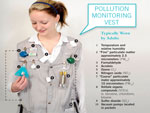Understanding Air Pollution in Our Communities
EPA conducted the Detroit Exposure and Aerosol Research Study (DEARS) to help scientists understand how accurate air quality information collected at community monitors represents what people living in neighborhoods are exposed to every day. The study helped define factors that affect individual exposures to particulate matter and sources of other air toxics, such as cars, trucks, factories, and power plants.
DEARS involved the participation of 120 volunteers from various communities in Wayne County, Mich. During each of the three study periods, approximately 40 study participants wore personal air quality monitoring vests as they went about their days. The vests measured the air quality around them in their homes, places of work, and as they engaged in their daily activities. Study participants wore the vests for five summer days and five winter days. Volunteers came from different Detroit neighborhoods, with different air pollution levels. During the study, additional air quality monitors were placed in and around study participants’ homes, schools, and workplaces to collect additional data on air pollutants residents were exposed to.
Following the data collection period from 2004-2007, EPA scientists analyzed the data collected during DEARS — an effort which continues today. These research results have led to a better understanding of how well community air quality monitors represent individual exposures to air pollution in the Detroit area. DEARS also provided information about the links between air pollutants and health effects, such as blood pressure and heart rate.
Key findings from DEARS include the following:
- Particulate matter levels found in the outdoor environment varied from neighborhood to neighborhood, and were significantly affected by weather
- Human exposures to harmful pollutants varied considerably depending on the season, where people lived, and the kinds of activities they engaged in on a daily basis
- Exposure to specific kinds of airborne pollutants, such as potassium, were linked to changes in cardiovascular health
More DEARS findings can be found here
![[logo] US EPA](../gif/logo_epaseal.gif)





